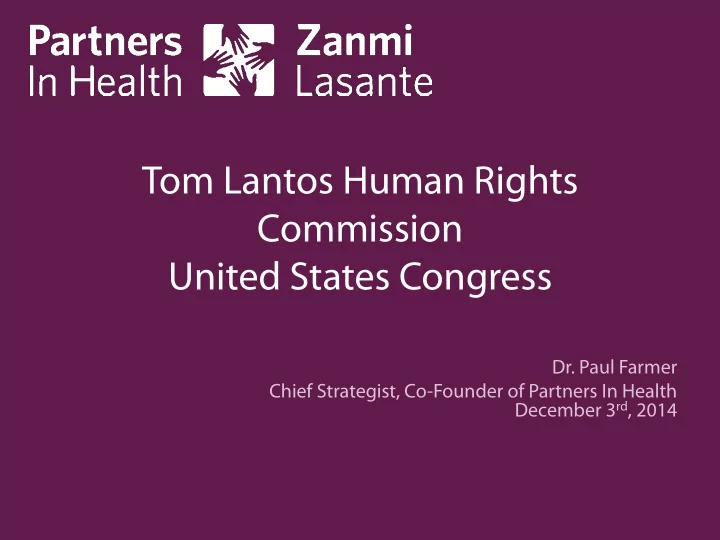

Tom Lantos Human Rights Commission United States Congress Dr. Paul Farmer Chief Strategist, Co-Founder of Partners In Health December 3 rd , 2014
Haiti After Quake Developments: • Under 5 mortality rate dropped by 11%, and maternal morality by 23%. • HIV infections reduced by 50% since 2008. • Overall life expectancy increased 3.5 years. • More than 1 million children are benefiting from free education since the introduction of the national program for free education in 2011. Challenges: • 58.7% of Haitians live in poverty and 24% in extreme poverty. • 60% lack access to basic healthcare. • 38% lack access to improved water sources and 69% to improved sanitation; water borne illnesses, including cholera, remain a leading cause of death among children. • More than 700,000 people have contracted cholera since the outbreak began in 2010 and more than 8,600 have died. • The prevalence of acute malnutrition amongst children under five increased from 5.1% in 2012 to 6.5% in 2013. 2 ¡
Aid to Haiti 9.7% Between 2010-2012, $6.4 billion in aid was disbursed to Haiti. Of the $6.4 billion, 9.1% was channeled to the Government of Haiti, Other and 0.6% to local 90.3% NGOs. The Government of Haiti and Local NGOs 3 ¡
Haiti: .9% of Humanitarian Aid was Invested in National Systems RECIPIENTS OF $2.42 BILLION IN HUMANITARIAN AID DISBURSED BY DONORS TO HAITI FROM 2010 TO 2012 (IN USD MILLIONS) 4.7% Donors’ civil and military entities with a mandate to respond to 0.9% disasters: 34.3 per cent or $830.6 million 5.2% Other non state service providers (NGOs and private contractors): 28.0 per cent or $676.4 million 34.3% UN entities and international NGOs as part of the UN flash appeal: 26.9 per cent of $651.6 million 26.9% Recipient of in-kind goods and services not identified: 5.2 per cent of $125.3 million International Federation of the Red Cross and National Red 28.0% Cross Societies: 4.7 per cent or $112.5 million Government of Haiti: 0.9 per cent or $22.5 million 4 ¡
Local Organizations and Businesses Received an Estimated .6% of Humanitarian Aid RECIPIENTS OF $6.43 BILLION IN HUMANITARIAN AND RECOVERY AID TO HAITI DISBURSED BY DONORS FROM 2010 TO 2012 (IN USD MILLIONS) 0.6% Donor agencies, multilaterals, NGOs and contractors*: 56.9 percent or $3.66 billion (estimate) 9.1% Unspecified or in-kind: 18.0 percent or $1.16 billion 15.4% In support of the GOH: 15.4 percent or $992.1 million 56.9% Government of Haiti using country systems: 18.0% 9.1 percent of $582.3 million (estimate) Haitian non-government or private organizations: 0.6 percent or $37.10 million (estimate) * ¡ Likely to be primarily international, but may include some local service providers that have not been fully specified. The category includes donor agencies acting as direct service providers. 5 ¡
Cholera in Haiti Though suspected cases of cholera have declined by 76% in 2014, there has been a recent upsurge in cases and fatalities. Epidemiological Evolution of Cholera in Haiti, 2010-2014 Year Oct-Dec 2011 2012 2013 Jan – Total 2010 Nov 2014 Cases 185,351 352,033 101,503 58,574 14,869 712,330 Fatalities 4,101 2,927 908 587 132 8,655 Fatality 2.2% 0.8% 0.9% 1.0% 1% 1.2% Rate 6 ¡
International Response to the Cholera Outbreak in Haiti • The National Plan for the Elimination of Cholera in Haiti will require $2.2 billion for ten years, 2013-2022. • To date, donors have pledged $395 million (17.3% of the requirement) and disbursed $268.5 million (12.1% of the requirement). • 57.9% of the pledges are in support of the Ministry of Public Works. 12.1% Disbursements Against Requirement 17.8% Pledges Against Requirement $2.2 billion Total Requirement 7 ¡
Ebola • As of November 21, 2014, there 2010 Recipients of Aid to Liberia have been 15,935 reported cases, with 5,689 fatalities. 3.5% • Prior to the outbreak, Liberia had Other one physician for every 100,000 people, Sierra Leone had two. The The United States has 245. Government of Liberia 97% • Eight Americans have contracted Ebola, eight have survived. 8 ¡
Cholera and Ebola and Weak National Systems • There remains little international support for national systems in Haiti and Liberia, with each country receiving 10.8% and 3.5%, respectively, of its aid through national systems. • Countries in fragility receive an estimated 30% of all global aid, approximately $50 billion a year—77% continues to bypass the systems of local public institutions. • Among countries in fragility, the strongest performers on the Millennium Development Goals (MDGs) receive 28% more aid through their national systems than others. 9 ¡
Strong Correlation Between Use of Country Systems In Fragile States and MDG Progress 8 7 Egypt 6 Mali Nepal *Rwanda Pakistan Uganda Ethiopia MDD Progress Score (2013) Malawi 5 Timor-Leste Bosnia and Herz. Burkina Faso Bangladesh Niger Mauritania Solomon Islands 4 Togo Comoros Afghanistan Liberia Cameroon Haiti 3 Nigeria Madagascar Guinea-Bissau CAR Sierra Leone 2 Kenya Chad Sudan Burundi 1 DRC 0 0 10 20 30 40 50 60 70 Percentage of ODA Through Country Systems 10 ¡
Five Myths Five Ways Forward 1) Reward sta ff who localize aid dollars. 1) Foreign aid doesn’t work. 2) Prioritize implementation through and 2) It is possible to lift countries out of with national counterparts. poverty without working with the public sector. 3) Reassess how we evaluate risk. 3) NGOs are the solution. 4) Challenge common assumptions about what is considered “sustainable” and 4) Poor countries are too corrupt to work “cost-e ff ective” in fragile settings. with. 5) Prioritize the transfer of function to local 5) It is not cost-e ff ective providing high authorities. quality services in developing countries. 11 ¡
Recommend
More recommend